Abstract
In higher primates, the coding region of the gene for involucrin, an epidermal protein, is mostly composed of a recently generated (modern) segment of repeats of a sequence of 10 codons. While the rest of the coding region has evolved only by nucleotide substitutions, the modern segment has evolved by successive addition of repeats. This process has not taken place randomly; instead, the expansion of the modern segment has been progressive from 3' to 5' end, thus adding vectorially regions that have been defined as early, middle, and late. The relatedness of the human, chimpanzee, and gorilla may be analyzed with greatest sensitivity by comparing their middle regions. The chimpanzee involucrin gene is more closely related to that of the gorilla than to that of the human.
Full text
PDF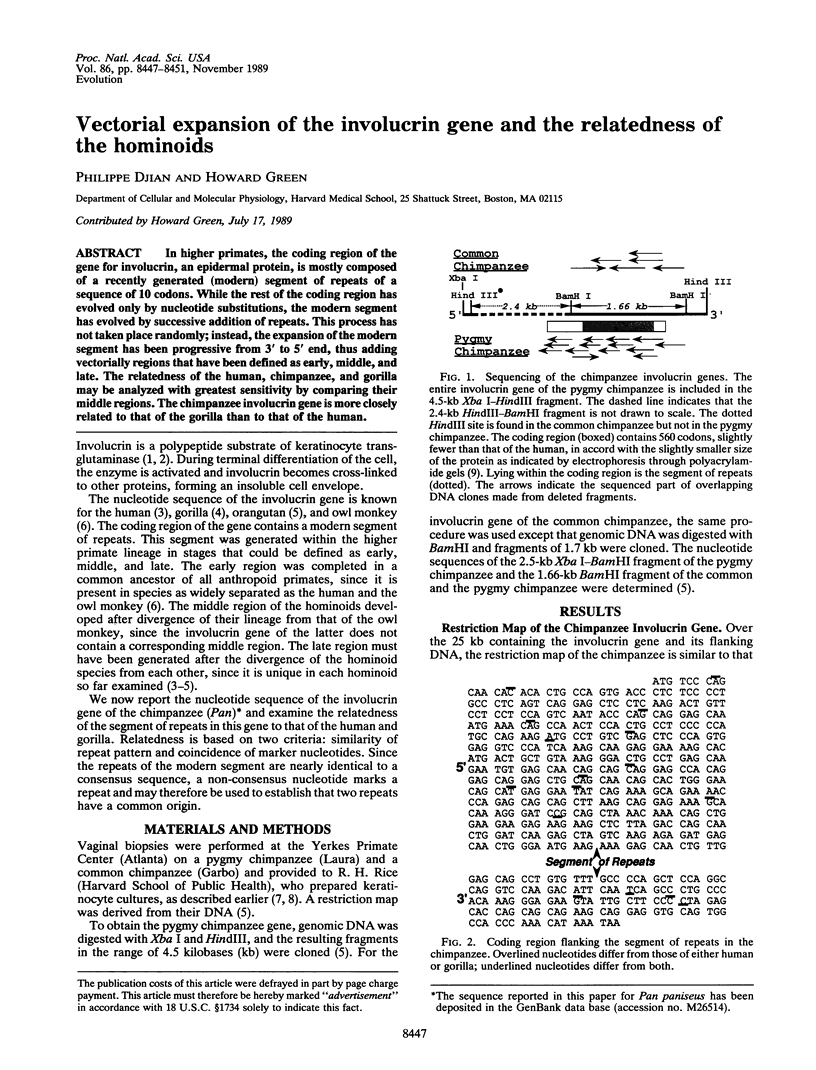
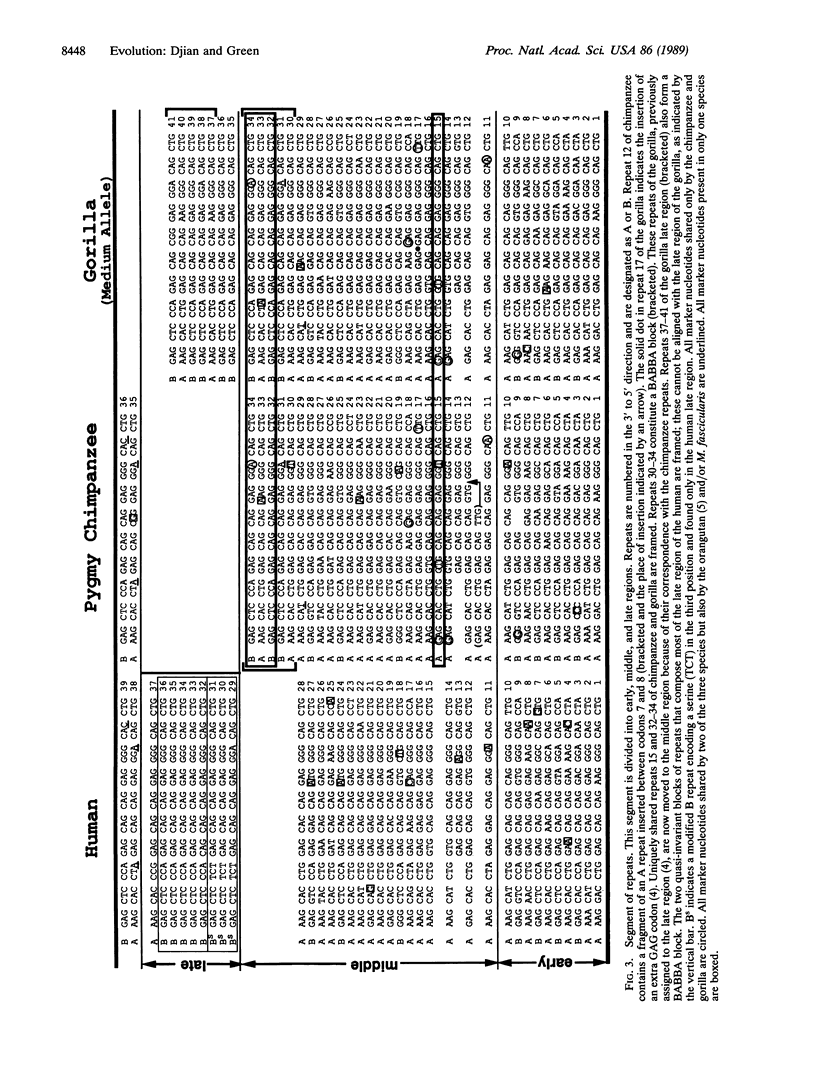
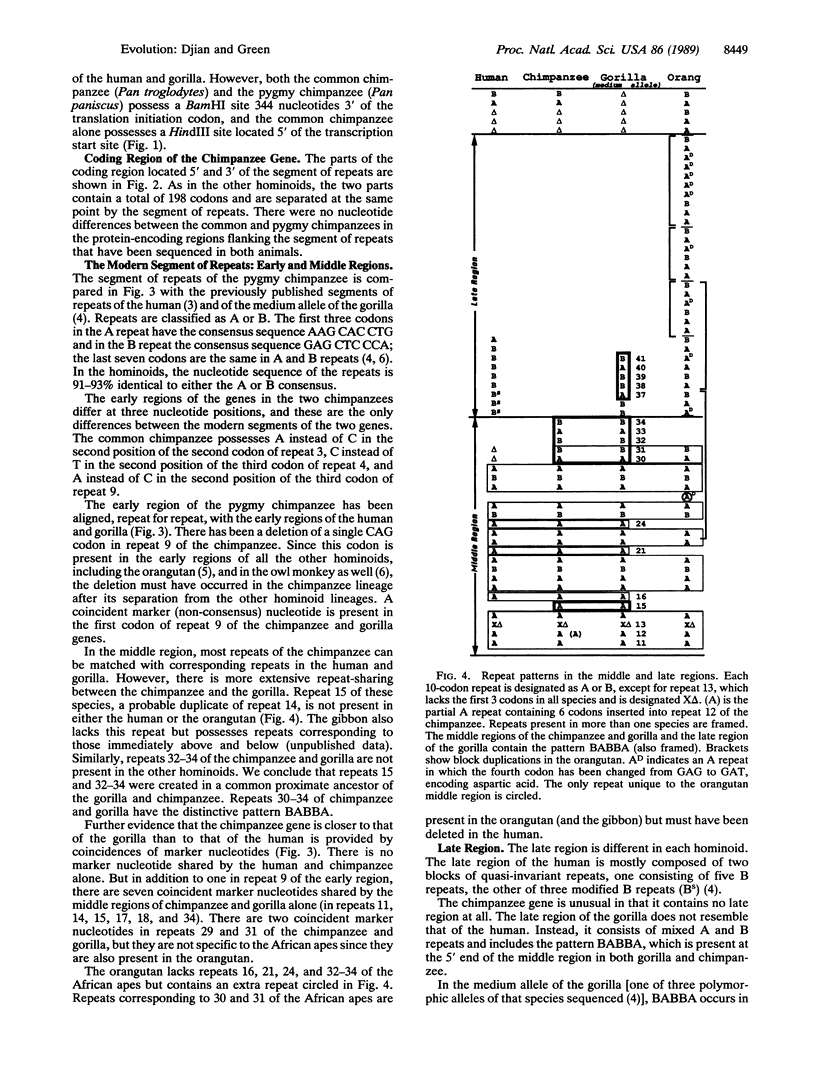
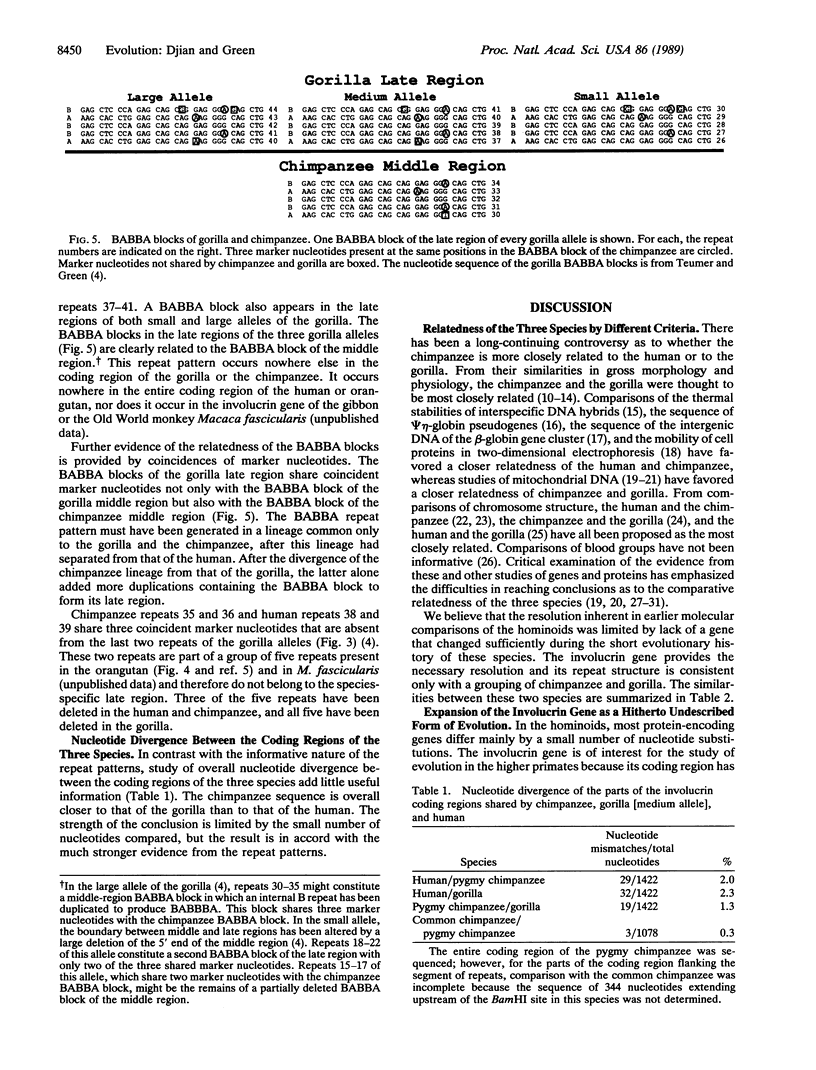
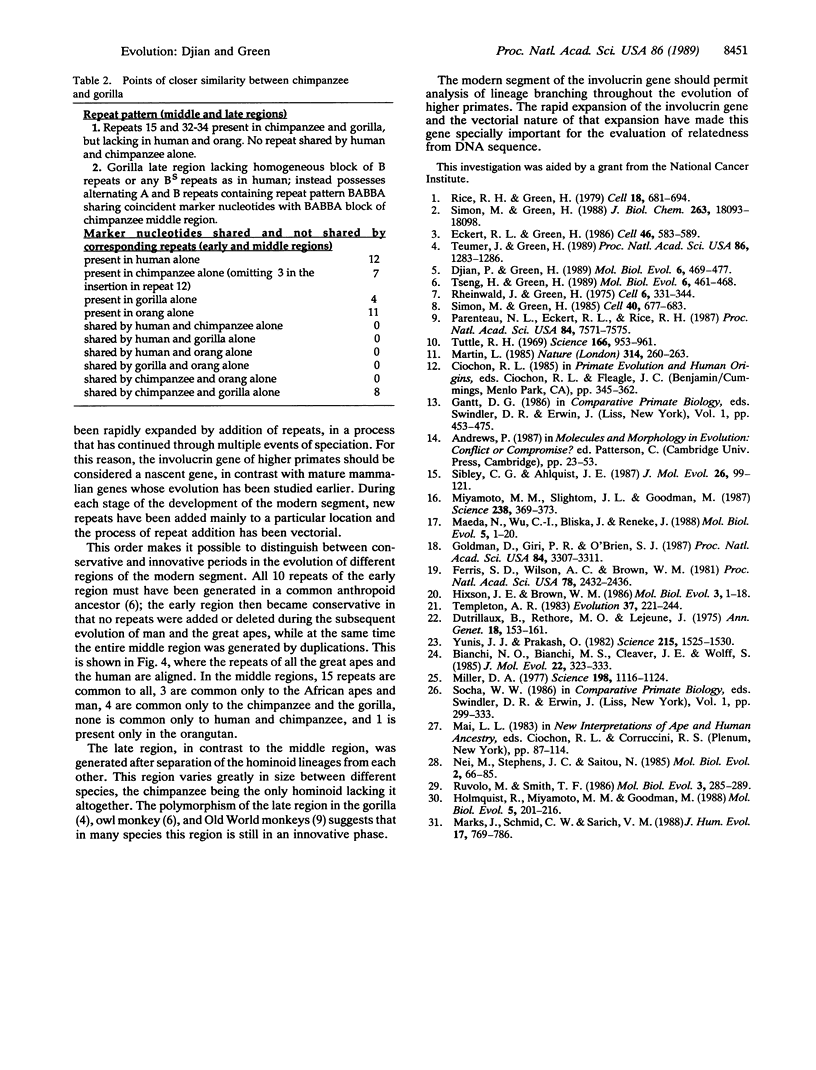
Images in this article
Selected References
These references are in PubMed. This may not be the complete list of references from this article.
- Bianchi N. O., Bianchi M. S., Cleaver J. E., Wolff S. The pattern of restriction enzyme-induced banding in the chromosomes of chimpanzee, gorilla, and orangutan and its evolutionary significance. J Mol Evol. 1985;22(4):323–333. doi: 10.1007/BF02115688. [DOI] [PubMed] [Google Scholar]
- Djian P., Green H. The involucrin gene of the orangutan: generation of the late region as an evolutionary trend in the hominoids. Mol Biol Evol. 1989 Sep;6(5):469–477. doi: 10.1093/oxfordjournals.molbev.a040570. [DOI] [PubMed] [Google Scholar]
- Dutrillaux B., Rethoré M. O., Lejeune J. Comparaison du caryotype de l'orang-outang (Pongo pygmaeus) à celui de l'homme, du chimpanzé et du gorille. Ann Genet. 1975 Sep;18(3):153–161. [PubMed] [Google Scholar]
- Eckert R. L., Green H. Structure and evolution of the human involucrin gene. Cell. 1986 Aug 15;46(4):583–589. doi: 10.1016/0092-8674(86)90884-6. [DOI] [PubMed] [Google Scholar]
- Ferris S. D., Wilson A. C., Brown W. M. Evolutionary tree for apes and humans based on cleavage maps of mitochondrial DNA. Proc Natl Acad Sci U S A. 1981 Apr;78(4):2432–2436. doi: 10.1073/pnas.78.4.2432. [DOI] [PMC free article] [PubMed] [Google Scholar]
- Goldman D., Giri P. R., O'Brien S. J. A molecular phylogeny of the hominoid primates as indicated by two-dimensional protein electrophoresis. Proc Natl Acad Sci U S A. 1987 May;84(10):3307–3311. doi: 10.1073/pnas.84.10.3307. [DOI] [PMC free article] [PubMed] [Google Scholar]
- Hixson J. E., Brown W. M. A comparison of the small ribosomal RNA genes from the mitochondrial DNA of the great apes and humans: sequence, structure, evolution, and phylogenetic implications. Mol Biol Evol. 1986 Jan;3(1):1–18. doi: 10.1093/oxfordjournals.molbev.a040379. [DOI] [PubMed] [Google Scholar]
- Holmquist R., Miyamoto M. M., Goodman M. Higher-primate phylogeny--why can't we decide? Mol Biol Evol. 1988 May;5(3):201–216. doi: 10.1093/oxfordjournals.molbev.a040493. [DOI] [PubMed] [Google Scholar]
- Maeda N., Wu C. I., Bliska J., Reneke J. Molecular evolution of intergenic DNA in higher primates: pattern of DNA changes, molecular clock, and evolution of repetitive sequences. Mol Biol Evol. 1988 Jan;5(1):1–20. doi: 10.1093/oxfordjournals.molbev.a040479. [DOI] [PubMed] [Google Scholar]
- Martin L. Significance of enamel thickness in hominoid evolution. Nature. 1985 Mar 21;314(6008):260–263. doi: 10.1038/314260a0. [DOI] [PubMed] [Google Scholar]
- Miller D. A. Evolution of primate chromosomes. Science. 1977 Dec 16;198(4322):1116–1124. doi: 10.1126/science.929190. [DOI] [PubMed] [Google Scholar]
- Miyamoto M. M., Slightom J. L., Goodman M. Phylogenetic relations of humans and African apes from DNA sequences in the psi eta-globin region. Science. 1987 Oct 16;238(4825):369–373. doi: 10.1126/science.3116671. [DOI] [PubMed] [Google Scholar]
- Nei M., Stephens J. C., Saitou N. Methods for computing the standard errors of branching points in an evolutionary tree and their application to molecular data from humans and apes. Mol Biol Evol. 1985 Jan;2(1):66–85. doi: 10.1093/oxfordjournals.molbev.a040333. [DOI] [PubMed] [Google Scholar]
- Parenteau N. L., Eckert R. L., Rice R. H. Primate involucrins: antigenic relatedness and detection of multiple forms. Proc Natl Acad Sci U S A. 1987 Nov;84(21):7571–7575. doi: 10.1073/pnas.84.21.7571. [DOI] [PMC free article] [PubMed] [Google Scholar]
- Rheinwald J. G., Green H. Serial cultivation of strains of human epidermal keratinocytes: the formation of keratinizing colonies from single cells. Cell. 1975 Nov;6(3):331–343. doi: 10.1016/s0092-8674(75)80001-8. [DOI] [PubMed] [Google Scholar]
- Rice R. H., Green H. Presence in human epidermal cells of a soluble protein precursor of the cross-linked envelope: activation of the cross-linking by calcium ions. Cell. 1979 Nov;18(3):681–694. doi: 10.1016/0092-8674(79)90123-5. [DOI] [PubMed] [Google Scholar]
- Ruvolo M., Smith T. F. Phylogeny and DNA-DNA hybridization. Mol Biol Evol. 1986 May;3(3):285–289. doi: 10.1093/oxfordjournals.molbev.a040396. [DOI] [PubMed] [Google Scholar]
- Sibley C. G., Ahlquist J. E. DNA hybridization evidence of hominoid phylogeny: results from an expanded data set. J Mol Evol. 1987;26(1-2):99–121. doi: 10.1007/BF02111285. [DOI] [PubMed] [Google Scholar]
- Simon M., Green H. Enzymatic cross-linking of involucrin and other proteins by keratinocyte particulates in vitro. Cell. 1985 Mar;40(3):677–683. doi: 10.1016/0092-8674(85)90216-8. [DOI] [PubMed] [Google Scholar]
- Simon M., Green H. The glutamine residues reactive in transglutaminase-catalyzed cross-linking of involucrin. J Biol Chem. 1988 Dec 5;263(34):18093–18098. [PubMed] [Google Scholar]
- Teumer J., Green H. Divergent evolution of part of the involucrin gene in the hominoids: unique intragenic duplications in the gorilla and human. Proc Natl Acad Sci U S A. 1989 Feb;86(4):1283–1286. doi: 10.1073/pnas.86.4.1283. [DOI] [PMC free article] [PubMed] [Google Scholar]
- Tseng H., Green H. The involucrin gene of the owl monkey: origin of the early region. Mol Biol Evol. 1989 Sep;6(5):460–468. doi: 10.1093/oxfordjournals.molbev.a040563. [DOI] [PubMed] [Google Scholar]
- Tuttle R. H. Knuckle-walking and the problem of human origins. Science. 1969 Nov 21;166(3908):953–961. doi: 10.1126/science.166.3908.953. [DOI] [PubMed] [Google Scholar]
- Yunis J. J., Prakash O. The origin of man: a chromosomal pictorial legacy. Science. 1982 Mar 19;215(4539):1525–1530. doi: 10.1126/science.7063861. [DOI] [PubMed] [Google Scholar]



